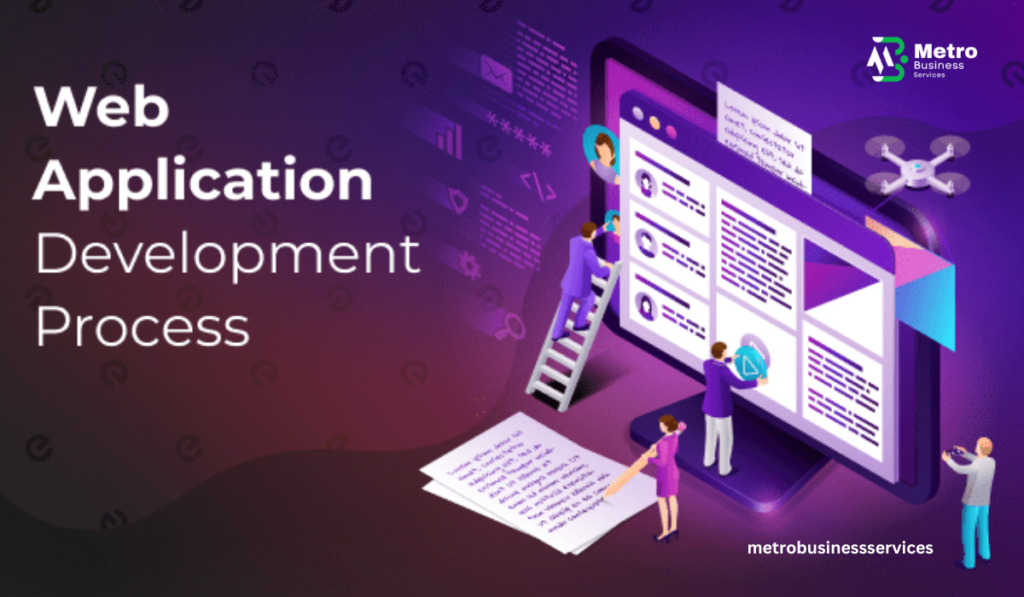In today’s digital age, having a robust web presence is essential for any business, regardless of size or industry. Imagine a world where your business operates 24/7, reaching customers across the globe with minimal overhead costs. Web applications make this possible, offering interactive and dynamic experiences that static websites cannot match. Whether you’re looking to streamline operations, engage customers, or innovate in your industry, web applications are the key to unlocking these opportunities. Web Application Development: A Complete Guide will walk you through everything you need to know about creating powerful web applications, from planning and design to deployment and maintenance. By the end, you’ll have a clear understanding of how to turn your vision into a functional and successful web application.
What is Web Application Development?

Web application development refers to the process of building software applications that run on web browsers. Unlike traditional desktop applications, web apps are accessible from any device with an internet connection, making them highly versatile.
The development of web applications involves several stages, including planning, designing, coding, testing, and deployment. It combines front-end development (user interface) and back-end development (server-side logic) to create a seamless user experience.
Why is Web Application Development Important?
Web applications have become indispensable for businesses due to their numerous benefits:
- Accessibility: Users can access web apps from anywhere, at any time.
- Scalability: Web apps can handle growing user bases and data volumes.
- Cost-Effectiveness: Developing custom web applications is often more affordable than building native apps.
- Integration: Web apps can easily integrate with other tools and platforms, enhancing functionality.
For businesses looking to innovate, bespoke web application development offers tailored solutions that align with specific goals and requirements.
Types of Web Applications
Web applications come in various forms, each serving unique purposes:
- Static Web Applications: Simple apps with fixed content, ideal for informational websites.
- Dynamic Web Applications: Apps that update content in real-time based on user interactions.
- E-commerce Applications: Platforms for online shopping and transactions.
- Content Management Systems (CMS): Tools for managing and publishing digital content.
- Progressive Web Apps (PWAs): Apps that offer native app-like experiences on the web.
Choosing the right type depends on your business needs and target audience.
The Web Application Development Process

Creating a web application involves a structured process to ensure success. Here’s a step-by-step breakdown:
Planning and Research
Before diving into developing web applications, it’s essential to define your objectives, target audience, and key features. This stage sets the foundation for the entire project.
Designing the User Interface (UI)
A well-designed UI is crucial for user engagement. Focus on creating intuitive layouts, responsive designs, and visually appealing interfaces. Tools like wireframes and prototypes can help visualize the final product.
Front-End Development
Front-end development involves coding the client-side of the application using HTML, CSS, and JavaScript. This ensures that users can interact with the app seamlessly.
Back-End Development
The back-end handles server-side logic, databases, and APIs. It ensures the app functions correctly and securely. Popular back-end technologies include Node.js, Python, and Ruby on Rails.
Database Management
Databases store and manage app data. Choosing the right database system (e.g., MySQL, MongoDB) and designing efficient schemas are critical for performance.
Testing and Quality Assurance
Thorough testing ensures the app is bug-free and meets all requirements. Types of testing include unit testing, integration testing, and user acceptance testing (UAT).
Deployment
Once tested, the app is deployed to a server and made available to users. Choose a reliable hosting provider and configure settings for optimal performance.
Maintenance and Updates
Web application development doesn’t end at deployment. Regular updates and maintenance are necessary to fix bugs, add features, and improve performance based on user feedback.
Key Technologies for Web Application Development

To build a successful web app, you need the right tools and technologies. Here are some popular options:
Front-End Technologies
- HTML/CSS: For structuring and styling web pages.
- JavaScript: For adding interactivity and dynamic content.
- React.js/Angular.js: Frameworks for building complex user interfaces.
Back-End Technologies
- Node.js: A runtime environment for server-side development.
- Python/Django: Ideal for data-driven applications.
- Ruby on Rails: Known for its simplicity and speed.
Database Technologies
- MySQL: A relational database management system.
- MongoDB: A NoSQL database for handling unstructured data.
Development Tools
- Git: For version control and collaboration.
- Docker: For containerizing applications.
- Jenkins: For continuous integration and deployment.
Benefits of Custom Web Application Development
Custom web apps offer several advantages over off-the-shelf solutions:
- Tailored Solutions: Designed to meet specific business needs.
- Scalability: Can grow with your business.
- Enhanced Security: Built with robust security measures to protect sensitive data.
- Competitive Edge: Unique features that set you apart from competitors.
For businesses seeking bespoke custom web app development, partnering with experts like Metrobusinessservices ensures high-quality, scalable, and secure solutions.
Challenges in Web Application Development

While web apps offer numerous benefits, they also come with challenges:
- Security Risks: Vulnerabilities like SQL injection and cross-site scripting (XSS) must be addressed.
- Performance Issues: Slow load times can frustrate users and impact engagement.
- Cross-Browser Compatibility: Ensuring the app works seamlessly across different browsers.
- Maintenance Costs: Regular updates and bug fixes require ongoing investment.
Future Trends in Web Application Development
The field of web application development is constantly evolving. Here are some trends to watch:
- Progressive Web Apps (PWAs): Offering native app-like experiences on the web.
- Artificial Intelligence (AI): Enhancing functionality with AI-driven features.
- Low-Code Development: Simplifying app creation with visual tools.
- Voice Search Integration: Making apps more accessible through voice commands.
Why Choose Metrobusinessservices?
At Metrobusinessservices, we specialize in Web Application Development: A Complete Guide to custom web application development. Our team of experts ensures your app is tailored to your business needs, scalable, and secure. Whether you need a bespoke web application or a custom web-based solution, we’ve got you covered.
FAQs
What is a web development application?
A web development application is a software tool used to create, test, and deploy web applications.
What are the 7 stages of web development?
The 7 stages include planning, analysis, design, development, testing, deployment, and maintenance.
How to build a web application development?
Start by defining objectives, designing the app, coding, testing, and deploying it. Use frameworks and tools to streamline the process.
Which web application development is best?
The best approach depends on your needs. Custom web app development offers tailored solutions, while low-code platforms provide faster deployment.
How do I create a complete web application?
Follow a structured process: plan, design, develop, test, deploy, and maintain. Use reliable tools and frameworks for efficiency.
How to learn web app development?
Take online courses, practice coding, and work on real-world projects. Platforms like Udemy and Codecademy offer excellent resources.
Is web application development easy?
While it requires technical skills, using frameworks and low-code platforms can simplify the process for beginners.
Conclusion
Web Application Development: A Complete Guide highlights the transformative process that empowers businesses to create dynamic, scalable, and user-friendly platforms tailored to their unique needs. From planning and design to deployment and maintenance, every step plays a crucial role in delivering a seamless user experience. By leveraging the right technologies, adhering to best practices, and staying updated with industry trends, businesses can build applications that drive engagement, efficiency, and growth. Whether you’re developing a custom web app or exploring bespoke web application development, partnering with experts like Metrobusinessservices ensures a high-quality, secure, and future-ready solution. Start your journey today and unlock the endless possibilities of web applications with this Complete Guide to Web Application Development!
